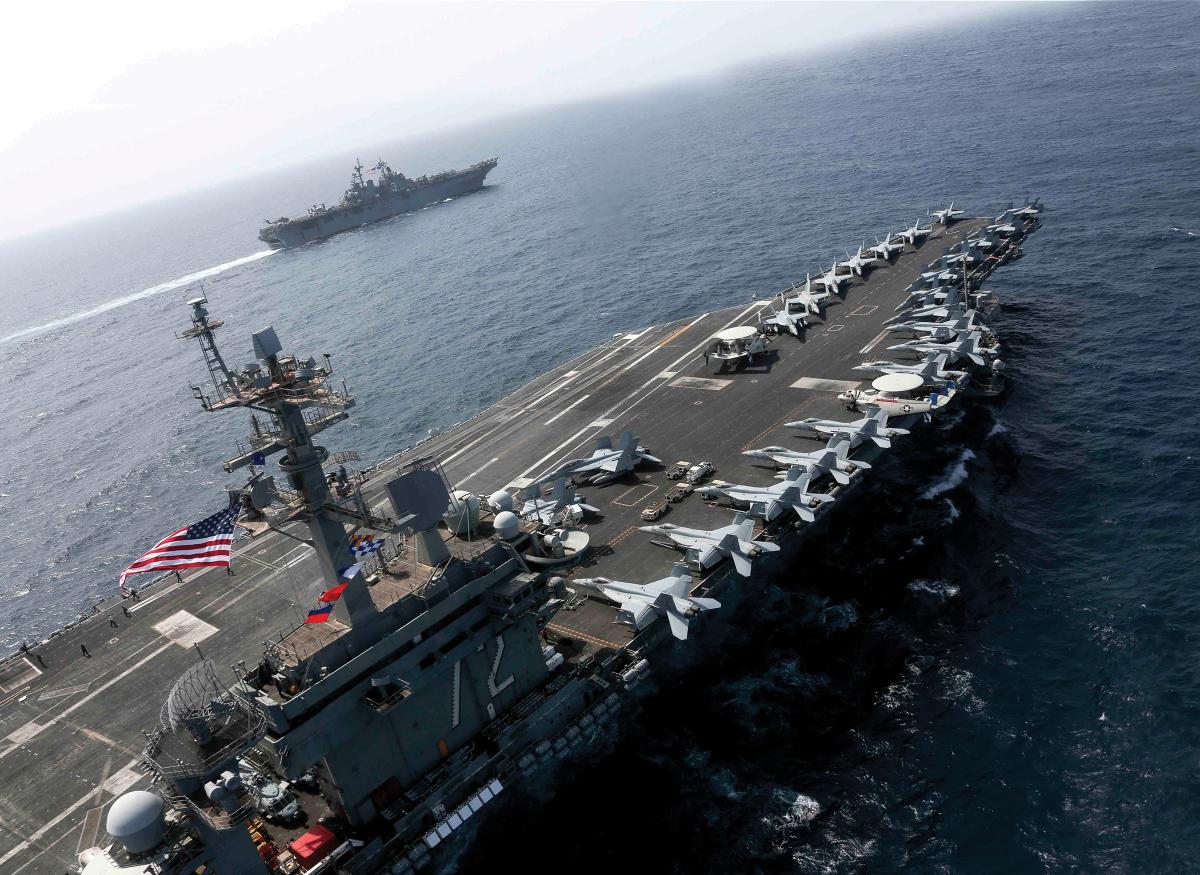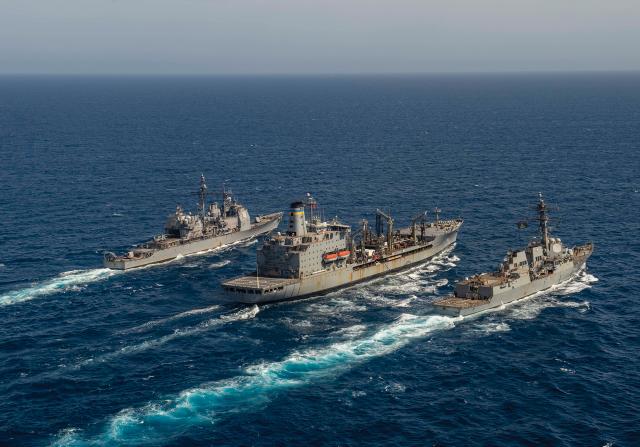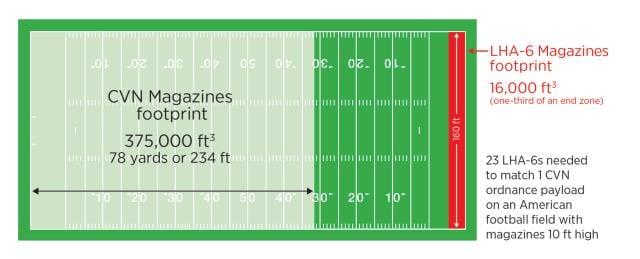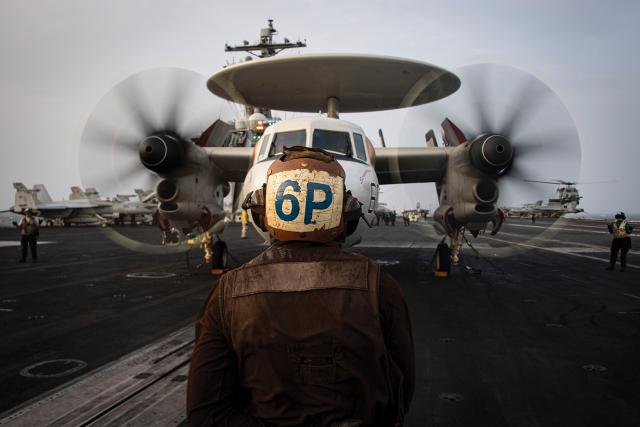A number of Proceedings articles and commentaries in the past several years have advanced the idea of saving money and fulfilling the vision of “distributed maritime operations” by building a fleet of more, smaller, lighter ships. For aircraft carriers, that argument tends to take the shape of more “Lightning carriers”—based on the hull form of amphibious assault ships such as the USS America (LHA-6) class—and fewer nuclear-powered carriers of the Nimitz (CVN-68) and Gerald R. Ford (CVN-78) classes.
While LHAs are cheaper to build than CVNs ($3 billion vs. $10 or more billion), the argument misses several key principles that allow CVNs to pack a lot more punch (orders of magnitude more, in fact) and deliver it more economically—and more combat effectively—than the smaller flattops.
In 1638 Galileo wrote his Dialogues Concerning Two New Sciences, in which he wondered why smaller objects moving through a fluid experience greater resistance than larger objects:“Observe then how much greater resistance, arising from the contact of the moving body with the medium, in the case of small bodies than in the case of large.”1
In the photo above, three ships, the USS San Jacinto (CG-56), the supply ship USNS Laramie (T-AO-203), and the USS James E. Williams (DDG-95), are conducting an underway replenishment, moving at the same speed.
Notice the churn of the ships’ wakes. The whiter the wake is, the more intense the churn. The more intense the churn, the harder the ship’s propulsion system is working to overcome the resistance the ship is experiencing. The wakes of the two smaller ships have a whiter, more intense churn than the supply ship’s. Even though those ships are more streamlined than the supply ship, the whiter wakes show they are experiencing proportionally greater resistance than the larger ship. This resistance difference is explained by Galileo’s cube–square law plus two other factors.
The first factor is viscous resistance, the friction of the water passing along the skin of the hull. Its effect is proportional to the surface area and increases linearly with the speed of the ship. Further, Galileo would note that the volume of the larger ship is much greater than that of the smaller ships, and the more intense churn of the smaller ships is the result of the fact “that the surface of a small solid is comparatively greater than that of the larger.” A little math using Galileo’s example of cubes, shown in the sidebar, should convince you of this.
The second factor is wave-making resistance, which increases exponentially at higher speeds and adds further resistance. When a surface ship moves through the water, it creates gravity waves that impede its movement. When it speeds up and makes a gravity wave as long as the ship, that speed is called the hull speed. Beyond that speed, the gravity waves grow exponentially in size and therefore add exponentially more resistance. So, the longer (and therefore larger) a ship is, the faster its hull speed. It is the best speed for a surface ship without adding much more power. The formula is: hull speed (knots) = 1.34 times the square root of the length of the hull in feet. An aircraft carrier with a 1,000-ft hull has a hull speed of 42 knots, whereas a destroyer with a 500-ft hull has a hull speed of about 30 knots.
Thus, by increasing the volume of things moving through water or air—container ships, oil tankers, or airliners—they scale up in size to carry more payload (and be more profitable), while their greatest life-cycle cost—fuel for propulsion—is proportional to a surface area that does not scale up as much as volume. This is an economy of scale. Indeed, the new locks at the Panama Canal are built bigger to capture the paying traffic of the new, larger commercial ships. The old locks are 1,050 ft long and 110 ft wide; the new locks are 1,400 ft long and 180 ft wide.2 Ships made to carry containers through the old locks were called Panamax ships and could carry 5,000 shipping containers. The New Panamax ships can carry 13,000 containers.
Now let’s consider LHAs or LHDs replacing CVNs. Carrier functions are spelled out in the Department of Defense (DoD) Mission Need Statement of 1996: “Independent of land bases, the aircraft carrier’s airwing must simultaneously perform surveillance, battle-space dominance and strike in extended combat operations forward.”3
Surveillance
The America class cannot operate airborne early-warning E-2D Hawkeye aircraft. They have no catapults to launch them, and no angled deck with arresting gear to recover them. Flying at altitude, an E-2D’s radar can see three times the range of the Aegis radar on a cruiser or destroyer, and the E-2D can move the center of that surveillance umbrella 10 times faster around a battle-group than two Aegis ship escorts. So, the airwing on an LHA cannot perform surveillance as effectively as the CVN’s airwing.
BattleSpace Dominance
This is the ability to see and defend against threats in the battlespace—under the water, on it, and or above it. The E-2D can communicate with the carrier strike group’s air warfare commander in the Aegis cruiser at the strike group’s center as well as with strikefighters in combat air patrols (CAP) several hundred miles from the center. A CVN can carry 75 or more aircraft, including 44 strikefighters, which can conduct long-range antiair and antisurface warfare.4 The Ford-class carriers have 56 aircraft spots on the flight deck and 24 in the hangar bay.
The USS America (LHA-6) deployed this year in an expeditionary strike group (ESG) with 5 F-35Bs. In 2016, the Navy demonstrated the Lightning carrier concept with 12 F-35Bs on her. But what degree of layered defense-in-depth can an ESG muster with an LHA as the primary strikefighter platform with about 20 aircraft spots on the flight deck and 10 in the hangar bay?
In CVX’s Analysis of Alternatives (AOA) for the new carrier in 1998, DoD examined three sizes of aircraft carriers and embarked air wings: 1) a small carrier with 40 aircraft, 2) a medium carrier with 60 aircraft, and 3) a large carrier with 80. DoD rejected the small 40-aircraft carrier because its air wing did not have enough strikefighters to simultaneously perform battlespace dominance and strike.5 One CAP station requires 12 strike-fighters operating as fighters or tankers for 12 hours. This leaves 32 strikefighters for strike missions. Two CAP stations require 22 strikefighters, allowing the other 22 strike/fighters to do strike.
Nothing has changed since 1998 to make an LHA/LHD with a smaller airwing more effective in performing those three functions. An LHA’s airwing does not have enough F-35Bs to do battlespace dominance or strike as effectively as a CVN’s air wing, and it cannot operate the E-2s to provide surveillance and command and control.
Magazine Size
Going back to the cube-square law again, the weapons magazines on a CVN are significantly bigger than those on an LHA. The magazines on an LHA are about 16,000 ft3, but those on the Nimitz- and Ford- class carriers are 375,000 ft3—allowing enough weapons to conduct strike and battle-space dominance missions for two weeks of extended combat operations.
The diagram of an American football field shows the difference in the size of the magazines of the two ships. The CVNs’ footprint, with magazines 10 ft high, stretches 78 yards or 234 ft from the end of the left end zone to the opposite 32-yard line. The LHA’s magazines take up just one-third of the right end zone, only 10 ft, on a football field 160 ft wide. The CVN’s magazines are more than 23 times larger than the LHA-6 magazines.
Nuclear vs. Conventional Power
Besides being able to steam around the world more than 60 times before refueling, where an LHA’s unrefueled range is about 12,000 miles, another advantage of CVNs was documented in the propulsion plant decision for the Ford class. Using nuclear power saved 500,000 ft3 of valuable internal space that would have been used for air intakes and smokestacks had it been powered by gas turbines. Much of that savings was applied to make the CVNs’ magazines larger than those on fossil-fueled carriers. Moreover, the island does not have to be located along the midpoint of the propulsion plant to optimize the smokestacks’ location. Instead, the island could be moved aft to allow the aircraft elevators to be located forward of the island and add the ready service magazines below the flight deck. This design element eliminates the bomb farm on the flight deck that exposes the weapons to the hazards of flight deck accidents.
Campaign Model
The real value of the large carrier was revealed in the CVX AoA used to determine the final carrier’s size. A campaign model for the Persian Gulf was used to compare performance of different sizes of air wings on medium and large carriers. The large airwings and carriers generated 8,000 strike sorties; the medium air wings and carriers generated 4,000.6,7
Interestingly, even the number of strike sorties produced by a medium-sized air wing is increased when that air wing operates from a large CVN. The medium airwing produced 5,600 sorties—40 percent increase, just by increasing the size of the carrier. With greater aviation fuel capacity and bigger magazines, a larger carrier keeps a smaller air wing on-station longer.8
The flexibility advantage of a large carrier is demonstrated in two important ways. First, in wartime, more aircraft and aircrew can be added quickly to a smaller air wing on a large carrier than on a smaller carrier. Further, the added types of aircraft can be selected for their ability to best meet emergent threats. For example, in 2014, when Islamic State fighters in Iraq gained antiair radars and missile batteries, more electronic attack EA-18Gs were added.9 Large carriers give the Navy greater warfighting flexibility.
The size, shape, and mix of ships the Navy needs is an ever-changing, multivariable equation. As threats change, the mix of ships and the tactics to employ them must adapt. However, it is critical to understand the underlying physical differences between different types of ships—and the physics that determines those differences—to make the right tradeoffs and the best fleet composition decisions. While it is tempting to think that two small Lightning carriers might provide equal firepower at less cost than one large, nuclear-powered carrier, that is simply not the case. Galileo’s cube–square law explains why today’s CVNs can carry a lot more aircraft and weapons farther and faster while fulfilling all the missions that carriers have to conduct better than smaller carriers.
1. Galileo, Concerning the Two New Sciences, Great Books of the Western World, Vol. 28, 1971, Encyclopaedia Britannica, Inc., p. 169.
2. Comparison of the lock sizes in the new and old Panama canals and the sizes of Panamax and New Panamax ships. http://maritime-connector.com/wiki/panamax/.
3. Department of Defense, CVX Mission Need Statement, 1996.
4. U.S. Navy Carrier Strike Group/Ships/Aircraft, www.navy.mil/navydata/our_ships.asp.
5. David Perin, Phase I Report of the CVX AOA, Center for Naval Analyses, 1997.
6. David Perin, Phase II Report, 1999.
7. The cost of a medium-sized carrier that can carry 60 aircraft is only 8 percent less than a large carrier because of the cost of the aircraft and special systems that make a ship an aircraft carrier. A medium-sized carrier is about 65,000 tons. The systems to handle aircraft—the catapults, arresting gear, aircraft elevators, weapons elevators, aircraft repair shops, and avionic maintenance shops—have to be as large and redundant on a medium carrier as on a large carrier for safety of flight and survivability. Arresting gear systems on the Nimitz class were reduced from four to three starting with CVN 76 and continuing on the Ford class.
8. The Director of the Department of Defense Office of Program Analysis and Evaluation (PA&E) mandated that the carriers used to determine the final size between medium or large have the same “robustness,” which included nuclear propulsion plants as well as armor and torpedo side-protection.
9. Interview with Chief of Naval Operations Admiral Jonathan Greenert by Shipmate on board the USS Carl Vinson (CVN-70). Admiral Greenert explains how extra EA-18G Growlers were added to carrier air wings to improve mission performance by jamming and attacking antiair radar/missile batteries. https://www.youtube.com/watch?v=mRhYtgw0mf0.






